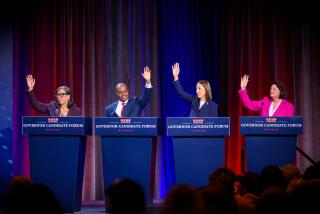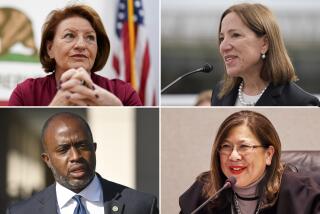Pastels, Not Bold Colors, in Governor’s Race
Desperate times call for desperate measures. Good times call for a good deal less.
With state unemployment approaching an eight-year low, crime at 1967 levels and optimism running riot, these are very good times for California. Times that call for incremental changes, not insurgency.
And the platforms of the four major candidates for California governor certainly fit the times.
None of the four contestants offers anything that amounts to radical change. All of them, Democrat and Republican alike, say they want to improve education, cut crime further and keep the economy humming, so even more citizens can reap the benefits.
For the most part, the candidates differ only in their approach to these uniform goals--and those differences often amount to little more than a matter of degree. “This is not the season for bold colors,” said Allan Hoffenblum, a Republican strategist.
Pastels are more like it.
There are, of course, plenty of distinctions between Republican Dan Lungren and his three chief Democratic rivals, Al Checchi, Gray Davis and Jane Harman.
State Atty. Gen. Lungren firmly opposes abortion; the Democrats support abortion rights. The Democrats favor stiffer gun controls; Lungren opposes a ban on cheap handguns. Lungren unabashedly advocates a greater role for religion in public life; the Democrats are silent on the subject.
Among the Democrats, however, the differences are far more stylistic than substantive. The biggest involve the candidates’ respective backgrounds and experience--businessman Checchi’s in the corporate world, Lt. Gov. Davis’ in government ranks--or gender, in the case of Torrance Rep. Harman.
Politically, Checchi has been the boldest of the bunch. Just Thursday, he outlined a gay-friendly agenda in West Hollywood. But aside from the sheer volume of his proposals, the bulk of them--like more police and less bureaucracy--are hardly lightning-rod items.
If the contest holds true to form, the fewer the actual differences between the candidates, the nastier the campaign will get as the June 2 primary approaches.
But for now, in the lull between the formal candidate announcements just ended and the full-tilt politicking just ahead, the most striking thing so far about the governor’s race is the scarcity of major initiatives and the tepid tone inspired by these tranquil times.
By contrast, “1994 was the year of fury,” in the words of Darry Sragow, a Checchi strategist and Democratic veteran of the last three gubernatorial races.
Mired in the depths of recession, with seemingly half the state fleeing to Montana, embattled Gov. Pete Wilson exploited concerns about street crime and illegal immigration to claw past his hapless Democratic opponent, Kathleen Brown, and win easy reelection.
Not incidentally, the year spawned two watershed changes in public policy: Proposition 187, the anti-illegal immigration initiative that was largely nullified by a federal judge and three-strikes legislation to put repeat criminals away for life. “There was not only anger there,” notes Sragow, “but a strong sense of fear.”
In 1990, the governor’s race was historic for a different reason: the precedent-shattering candidacy of former San Francisco Mayor Dianne Feinstein. (By this third go-round, with Harman running on the heels of Feinstein and Brown, some of the gender novelty has already worn off.)
History aside, the 1990 fight for the Democratic nomination featured a knock-down brawl between Feinstein and state Atty. Gen. John Van de Kamp that turned on ideology and issues like the death penalty--Feinstein for, Van de Kamp against. Looking back, their battle only serves to underscore the commonality among today’s crop of Democratic hopefuls.
Van de Kamp--foolishly, it turned out--staked his candidacy on Big Ideas, co-sponsoring a series of ballot initiatives dealing with crime, the environment and government reform. He lost the June primary, in no small part because the effort drained precious resources away from his gubernatorial campaign. All three ballot measures also were defeated.
By the fall of 1990, the onset of recession and the prospect of war with Iraq made the path-breaking Feinstein seem too risky for voters, who opted instead for the more tried-and-true Wilson.
After simmering down from the rage of 1994, the state’s voters seem once again leery of embracing too much change. With fat wallets and the future seemingly flush, Californians appear to have settled into a state of relatively contented equilibrium.
The most attention-grabbing measure on the June ballot, to overhaul the state’s system of bilingual education, really hasn’t grabbed that much attention. Conspicuously, not a single one of the four major gubernatorial candidates have jumped on board.
“They’re all playing for the moderate middle-of-the-road voters and when dealing with issues, they’re all very timid,” said GOP analyst Hoffenblum.
By November, when Californians get around to picking their next governor, some issue--manufactured or otherwise--will almost certainly strike a collective nerve. “Don’t try to judge a campaign by the way it starts out,” said Steve Merksamer, a Sacramento attorney and longtime Republican strategist. “There will be a defining issue to this campaign, just as there is a defining issue to every campaign.”
In 1974, it was political reform. In 1982, gun control. Four years ago, immigration proved decisive.
More to Read
Get the L.A. Times Politics newsletter
Deeply reported insights into legislation, politics and policy from Sacramento, Washington and beyond. In your inbox three times per week.
You may occasionally receive promotional content from the Los Angeles Times.











